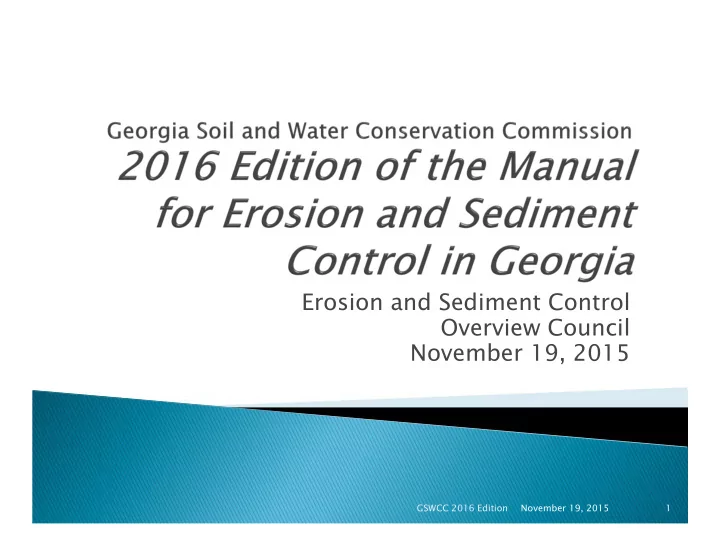

Erosion and Sediment Control Overview Council November 19, 2015 GSWCC 2016 Edition November 19, 2015 1
Part of a continuing process of revisions On December 18, 2014, the GSWCC State Board took no official action on the Sixth Edition (2014) of the Manual because of areas of concern and uncertainty For the calendar year 2015, both the Fifth (2013) and Sixth Editions of the Manual were available for use GSWCC 2016 Edition 2
Both Manuals in Effect GSWCC 2016 Edition 3
The Carl Vinson Institute of Government at the University of Georgia was brought in this summer to help consolidate and reconcile the Fifth and Sixth editions, along with a representative from: EPD GSWCC GDOT GSWCC 2016 Edition 4
Ensuring that the public understood the process and had opportunity to provide comments were important goals. GSWCC 2016 Edition 5
Public Public Comment Opportunities and Transparency Comment Opportunities and Transparency Draft Manual posted on website and 9/21/15 Approximately 20,000 circulated to listserv for comment emails on listserv. Public Meeting 10/1/15 Approximately 50 people in attendance; five gave public comment. Q&A period followed. Public Comment on Manual Closed 10/9/15 15 written comments received (67 issues raised) Manual Revised based on comments; 10/30/15 Approximately 20,000 list of comments and action taken emails on listserv. posted Proposed 2016 Manual presented to 11/3/15 Public Comment taken; GSWCC State Board unanimous approval by State Board Notice provided regarding State Board 11/4/15 Approximately 20,000 action and Overview Council meeting emails on listserv. GSWCC 2016 Edition 6
The Revision Process: 2016 Edition Draft • One Manual • Consolidated and Reconciled • Available for public comment on Sept 21, 2015 • Public meeting held on October 1, 2015 • Public comment closed on Oct. 9, 2015 GSWCC 2016 Edition 7
Major Changes: Testing Both in Effect Did not include Included performance performance evaluation evaluation Reconciled by adopting 5 th Edition approach GSWCC 2016 Edition 8
• GSWCC and GDOT coordinated to develop an Equivalent BMP Equivalent BMP list list based on existing GDOT QPL’s and GSWCC Board previously approved products as found in the 5 th Edition of the manual. • On Oct. 13, the draft draft Equivalent BMP List was posted on the GSWCC website and an email sent to the Manual Listserv. • Comments were taken on the draft draft list until Oct. 27. • The response to comments received was posted and distributed to the Listserv on November 12, 2015 November 12, 2015, along with the Final Revised Equivalent BMP List. GSWCC 2016 Edition 9
A new process for inclusion on and removal from the Equivalent BMP List. List will consist of BMPs that: ◦ have demonstrated success at least three times in the field under the NPDES permit Guidelines for the Alternative BMP process, ◦ have been bench tested, and ◦ have been approved for inclusion by the GSWCC. The Equivalent BMP List will be similar to the Georgia Department of Transportation’s (GDOT) Qualified Products List, which consists of materials approved by GDOT and was recognized by the Fifth Edition of the Manual. Refer to Appendix A-2 for more information on the process GSWCC 2016 Edition 10
The Manual will become effective January 1, 2016, along with the Equivalent BMP List. Applications for BMPs to be included on the Equivalent BMP list will be based on NOI’S submitted on or after January 1, 2016. As of January 1, 2016, any product that seeks to be on the GDOT QPL List must first go through the Equivalent BMP process. GSWCC’s approval of a BMP, however, does not ensure GDOT’s adoption of that item into their QPL, design policies, or procedures. The first update to the Equivalent BMP list will occur on or after March 31, 2016. GSWCC 2016 Edition 11
Some practices from the Fifth and Sixth Editions of the Manual have been revised or combined in the 2016 Edition, including: • Tree Protection (Tr) • Construction Exit (Co) • Turbidity Curtain (Tc) • Channel Stabilization (Ch) • Seep Berm (SpB) • Checkdam (Cd) • Sediment Barrier (Sd1) • Flocculants and • Inlet Sediment Trap (Sd2) Coagulants (Fl-Co) • Temporary Sediment • Slope Stabilization (Ss) Trap (Sd4) • Tackifiers (Tac). • Retrofit (Rt) • Floating Surface Skimmer (Sk) GSWCC 2016 Edition 12
Clarifies the use of Types A, B, and C silt fences in Non-sensitive and Sensitive areas. • Type A and Type B - Type A and Type B - Non-sensitive Non-sensitive • Type C – Type C – Sensitive Sensitive GSWCC 2016 Edition 13
Updated guidance for ES&PC Plans GSWCC 2016 Edition 14
Revised acknowledgments Clarified that mulch berms and compost socks are types of sediment barriers Clarified that Design Professionals shall practice in a manner that complies with applicable Georgia law. Clarified that only approved ASTM standards will be accepted for repeatable bench testing; working test methods will not be accepted for consideration on the Equivalent BMP List. GSWCC 2016 Edition 15
Revised where necessary to clarify whether language was advisory or not (should/shall) Clarified that a 12” mulch sock has not been approved; must be 18” for compost filter socks, staked 2ft on center. Comments on draft resulted in additional clarity that “GSWCC has the discretion to approve the application, deny the application, request a resubmittal, or request additional information, with consultation from EPD and GDOT.” Emphasized that requests for removal from list should focus on complaints independent of ordinary installation and maintenance of BMP. GSWCC 2016 Edition 16
GSWCC 2016 Edition 17
Recommend
More recommend